The Minima of Viscosities
Abstract
:1. Introduction
2. Minimal Viscosity from the Condensed Matter Approach
3. Effective Masses of Flowing Units
4. Discussion
5. Conclusions
Author Contributions
Funding
Institutional Review Board Statement
Informed Consent Statement
Data Availability Statement
Conflicts of Interest
References
- Douglas, R.W. The flow of glass. J. Soc. Glass Technol. 1949, 33, 138–162. [Google Scholar]
- Doremus, R.H. Viscosity of silica. J. Appl. Phys. 2002, 92, 7619. [Google Scholar] [CrossRef]
- Ojovan, M.I. Configurons: Thermodynamic parameters and symmetry changes at glass transition. Entropy 2008, 10, 334–364. [Google Scholar] [CrossRef]
- Hrma, P.; Ferkl, P.; Kruger, A.A. Arrhenian to non-Arrhenian crossover in glass melt viscosity. J. Non-Cryst. Solids 2023, 619, 122556. [Google Scholar] [CrossRef]
- Eyring, H. Viscosity, Plasticity, and Diffusion as Examples of Absolute Reaction Rates. J. Chem. Phys. 1936, 4, 283–291. [Google Scholar] [CrossRef]
- Kaptay, G. A unified equation for the viscosity of pure liquid metals. Int. J. Mater. Res. 2005, 96, 24–31. [Google Scholar] [CrossRef]
- Trachenko, K.; Brazhkin, V.V. Minimal quantum viscosity from fundamental physical constants. Sci. Adv. 2020, 6, eaba3747. [Google Scholar] [CrossRef]
- Gangopadhyay, A.K.; Nussinov, Z.; Kelton, K.F. Quantum mechanical interpretation of the minimum viscosity of metallic liquids. Phys. Rev. E 2022, 106, 054150. [Google Scholar] [CrossRef]
- Trachenko, K.; Brazhkin, V.V. The quantum mechanics of viscosity. Phys. Today 2021, 74, 66–67. [Google Scholar] [CrossRef]
- Ojovan, M.I.; Louzguine-Luzgin, D.V. On Crossover Temperatures of Viscous Flow Related to Structural Rearrangements in Liquids. Materials 2024, 17, 1261. [Google Scholar] [CrossRef]
- Ojovan, M.I. On Viscous Flow in Glass-Forming Organic Liquids. Molecules 2020, 25, 4029. [Google Scholar] [CrossRef] [PubMed]
- Bolmatov, D.; Zhernenkov, M.; Zav’yalov, D.; Tkachev, S.N.; Cunsolo, A.; Cai, Y.Q. The Frenkel Line: A direct experimental evidence for the new thermodynamic boundary. Sci. Rep. 2015, 5, 15850. [Google Scholar] [CrossRef] [PubMed]
- Louzguine-Luzgin, D.V.; Louzguina-Luzgina, L.V.; Fecht, H.J. On limitations of the viscosity versus temperature plot for glass-forming substances. Mater. Lett. 2016, 182, 355–358. [Google Scholar] [CrossRef]
- Mott, N.F. The viscosity of vitreous silicon dioxide. Philos. Mag. 1987, B56, 257–262. [Google Scholar] [CrossRef]
- Louzguine-Luzgin, D.V. Structural Changes in Metallic Glass-Forming Liquids on Cooling and Subsequent Vitrification in Relationship with Their Properties. Materials 2022, 15, 7285. [Google Scholar] [CrossRef] [PubMed]
- Xue, J.; Nogueira, F.S.; Kelton, K.F.; Nussinov, Z. Deviations from Arrhenius dynamics in high temperature liquids, a possible collapse, and a viscosity bound. Phys. Rev. Res. 2022, 4, 043047. [Google Scholar] [CrossRef]
- Patouillet, K.; Delacroix, J. Development of an oscillating cup viscometer for viscosity measurement of liquid metals at very high temperatures. Measurement 2023, 220, 113370. [Google Scholar] [CrossRef]
- IAEA. Liquid Metal Coolants for Fast Reactors Cooled by Sodium, Lead, and Lead-Bismuth Eutectic; IAEA Nuclear Energy Series NG-T-1.6; IAEA: Vienna, Austria, 2012; 81p. [Google Scholar]
- Lemmon, E.W.; Bell, I.H.; Huber, M.L.; McLinden, M.O. Thermophysical Properties of Fluid Systems. In NIST Chemistry WebBook, NIST Standard Reference Database Number 69; Linstrom, P.J., Mallard, W.G., Eds.; National Institute of Standards and Technology: Gaithersburg, MD, USA, 2023; p. 20899. [Google Scholar] [CrossRef]
- Frenkel, J. Kinetic Theory of Liquids; Oxford University Press: Oxford, UK, 1955. [Google Scholar]
- Chevallard, G.; Samwer, K.; Zaccone, A. Atomic-scale expressions for viscosity and fragile-strong behavior in metal alloys based on the Zwanzig-Mountain formula. Phys. Rev. Res. 2020, 2, 033134. [Google Scholar] [CrossRef]
- Trachenko, K.; Brazhkin, V.V. Collective modes and thermodynamics of the liquid state. Rep. Prog. Phys. 2016, 79, 016502. [Google Scholar] [CrossRef]
- Trachenko, K. Theory of Liquids: From Excitations to Thermodynamics; Cambridge University Press: Cambridge, UK, 2023. [Google Scholar]
- Zaccone, A. Viscosity of Supercooled Liquids. In Theory of Disordered Solids; Lecture Notes in Physics; Springer: Cham, Switzerland, 2023; Volume 1015. [Google Scholar] [CrossRef]
- Kittel, C. Introduction to Solid State Physics, 8th ed.; John Wiley & Sons, Inc.: Hoboken, NJ, USA, 2005. [Google Scholar]
- West, A.R. Basic Solid State Chemistry, 2nd ed.; John Wiley & Sons: Chichester, UK, 1999. [Google Scholar]
- Khamehchi, K.A. Negative-Mass Hydrodynamics in a Spin-Orbit–coupled Bose-Einstein Condensate. Phys. Rev. Lett. 2017, 118, 155301. [Google Scholar] [CrossRef]
- German, E.I.; Tsydypov, S.B.; Ojovan, M.I.; Darmaev, M.V. Structure of Argon Solid Phases Formed from the Liquid State at Different Isobaric Cooling Rates. Appl. Sci. 2024, 14, 1295. [Google Scholar] [CrossRef]
- Tournier, R.F.; Ojovan, M.I. Undercooled phase behind the glass phase with superheated medium-range order above glass transition temperature. Phys. B Condens. Matter 2021, 602, 412542. [Google Scholar] [CrossRef]
- Tanaka, H. Two-order parameter model of the liquid-glass transition. I. Relation of the liquid-glass transition and crystallization. J. Non-Cryst. Sol. 2005, 351, 3371–3384. [Google Scholar] [CrossRef]
- Steinhard, P.J.; Nelson, D.R.; Ronchetti, M. Bond-orientational order in liquid and glasses. Phys. Rev. B 1983, 28, 784–805. [Google Scholar] [CrossRef]
- Evteev, A.V.; Kosilov, A.T.; Levchenko, E.V.; Logachev, O.B. Kinetics of isothermal nucleation in a supercooled iron melt. Phys. Sol. State. 2006, 48, 577–582. [Google Scholar] [CrossRef]
- Di Cicco, A.; Trapananti, A.; Faggioni, S. Is There Icosahedral Ordering in Liquid and Undercooled Metals? Phys. Rev. Lett. 2003, 91, 135505-1–135505-4. [Google Scholar] [CrossRef]
- Shi, Q.L.; Wang, X.D.; Cao, Q.P.; Ding, S.Q.; Zhang, D.X.; Beyer, K.A.; Jiang, J.Z. Temperature-induced gradual polymorphic structural crossover in liquid indium, tin, and antimony. Phys. Rev. B 2024, 109, 024112. [Google Scholar] [CrossRef]
- Tournier, R.F. Presence of intrinsic growth nuclei in overheated and undercooled liquid elements. Phys. B 2007, 392, 79–91. [Google Scholar] [CrossRef]
- Stanzione, J.F., III; Strawhecker, K.E.; Wool, R.P. Observing the twinkling nature of the glass transition. J. Non-Cryst. Sol. 2011, 357, 311. [Google Scholar] [CrossRef]
- Tournier, R.F. First-order transitions in glasses and melts induced by solid superclusters nucleated by homogeneous nucleation instead of surface melting. Chem. Phys. 2019, 524, 40–54. [Google Scholar] [CrossRef]
- Benigni, P. CALPHAD modeling of the glass transition for a pure substance, coupling thermodynamics and relaxation kinetics. Calphad 2021, 72, 102238. [Google Scholar] [CrossRef]
- Ojovan, M.I.; Tournier, R.F. On structural rearrangements near the glass transition temperature in amorphous silica. Materials 2021, 14, 5235. [Google Scholar] [CrossRef] [PubMed]
- Hasmy, A.; Ispas, S.; Hehlen, B. Percolation transitions in compressed SiO2 glasses. Nature 2021, 599, 62–66. [Google Scholar] [CrossRef] [PubMed]
- Fischer, E.W.; Meier, G.; Rabenau, T.; Patkowski, A.; Steffen, W.; Thonnes, W. Density fluctuations around the glass-transition, of low molecular weight glass-forming liquids. J. Non-Cryst. Solids 1991, 131–133, 134–138. [Google Scholar] [CrossRef]
- Bokov, N.A. Non-equilibrium fluctuations as a plausible reason of the light scattering intensity peak in the glass transition region. J. Non-Cryst. Solids 2008, 354, 1119–1122. [Google Scholar] [CrossRef]
- Bakai, A.S. Long-range density fluctuations in glass-forming melts. J. Non-Cryst. Sol. 2002, 307–310, 623–629. [Google Scholar] [CrossRef]
- Kolokol, A.S.; Shimkevitch, A.L. Topological structure of liquid metals. At. Énergy 2005, 98, 187–190. [Google Scholar] [CrossRef]
- Tournier, R.F.; Beaugnon, E. Texturing by cooling a metallic melt in a magnetic field. Sci. Technol. Adv. Mater. 2009, 10, 014501. [Google Scholar] [CrossRef] [PubMed]
- Tournier, R.F. Crystallization of supercooled liquid elements induced by superclusters containing magic atom numbers. Metals 2014, 4, 354–387. [Google Scholar] [CrossRef]
- He, Y.; Wang, J.L.J.; Kou, H.; Beaugnon, E. Liquid-liquid structure transition and nucleation in undercooled Co-B eutectic alloys. Appl. Phys. A 2017, 123, 391. [Google Scholar] [CrossRef]
- Yue, Y. Experimental evidence for the existence of an ordered structure in a silicate liquid above its liquidus temperature. J. Non-Cryst. Sol. 2004, 345–346, 523–527. [Google Scholar] [CrossRef]
- Tournier, R.F.; Ojovan, M.I. Dewetting Temperatures of Prefrozen and Grafted Layers in Ultrathin Films Viewed as Melt-Memory Effects. Phys. B Condens. Matter 2021, 611, 412796. [Google Scholar] [CrossRef]
- Pandav, G.; Pryamitsyn, V.; Errington, J.; Ganesan, V. Multibody Interactions, Phase Behavior, and Clustering in Nanoparticle–Polyelectrolyte Mixtures. J. Phys. Chem. B 2015, 119, 14536–14550. [Google Scholar] [CrossRef] [PubMed]
- Bernabei, M.; Botti, A.; Bruni, F.; Ricci, M.A.; Soper, A.K. Percolation and three-dimensional structure of supercritical water. Phys. Rev. E 2008, 78, 021505. [Google Scholar] [CrossRef] [PubMed]
- Boiling Point of the Elements. Available online: https://periodictable.com/Properties/A/BoilingPoint.al.html (accessed on 3 April 2024).
- Blair, S.; Abassi, M.H. Internal Pressure Approach for the Estimation of Critical Temperatures of Liquid Metals. Acustica 1993, 79, 64–72. [Google Scholar]
- Cahill, J.A.; Kirshenbaum, A.D. The density of liquid bismuth from its melting point to its normal boiling point and an estimate of its critical constants. J. lnorg. Nucl. Chem. 1963, 25, 501–506. [Google Scholar] [CrossRef]
- Meyer, N.; Xu, H.; Wax, J.-F. Temperature and density dependence of the shear viscosity of liquid sodium. Phys. Rev. B 2016, 93, 214203. [Google Scholar] [CrossRef]
- Meyer, N.; Xu, H.; Wax, J.-F. Universality of the shear viscosity of alkali metals. Phys. Rev. B 2017, 96, 094201. [Google Scholar] [CrossRef]
- Withington, M.; Devereux, H.L.; Cockrell, C.; Elena, A.M.; Todorov, I.T.; Liu, Z.K.; Shang, S.L.; McCloy, J.S.; Bingham, P.A.; Trachenko, K. Viscosity bounds in liquids with different structure and bonding types. Phys. Rev. B 2024, 109, 094205. [Google Scholar] [CrossRef]
- Sedov, L.I. Similarity and Dimensional Methods in Mechanics, 10th ed.; CRC Press: Boca Raton, FL, USA, 1993; 496p. [Google Scholar] [CrossRef]
- Aasen, T.H.; Wang, K. Properties of laser-targeted Rydberg Matter with changes in pressure and magnetic field. Surf. Interfaces 2024, 47, 104231. [Google Scholar] [CrossRef]
- Aasen, T.H.; Zeiner-Gundersen, D.H.; Zeiner-Gundersen, S.; Ohlckers, P.; Wang, K. A condensed excited (Rydberg) matter: Perspective and applications. J. Clust. Sci. 2021, 33, 839–852. [Google Scholar] [CrossRef]
- Ojovan, M.I. Rydberg matter clusters: Theory of interaction and sorption properties. J. Clust. Sci. 2012, 23, 35–46. [Google Scholar] [CrossRef]
- Holmlid, L. Experimental studies and observations of clusters of Rydberg matter and its extreme forms. J. Clust. Sci. 2012, 23, 5–34. [Google Scholar] [CrossRef]
- Gao, S.; Jiao, K.; Zhang, J.; Fan, X.; Liu, Z.; Zheng, A. Review on the Viscosity of Iron-based Melts in Metallurgical Process. ISIJ Int. 2022, 62, 2172–2218. [Google Scholar] [CrossRef]
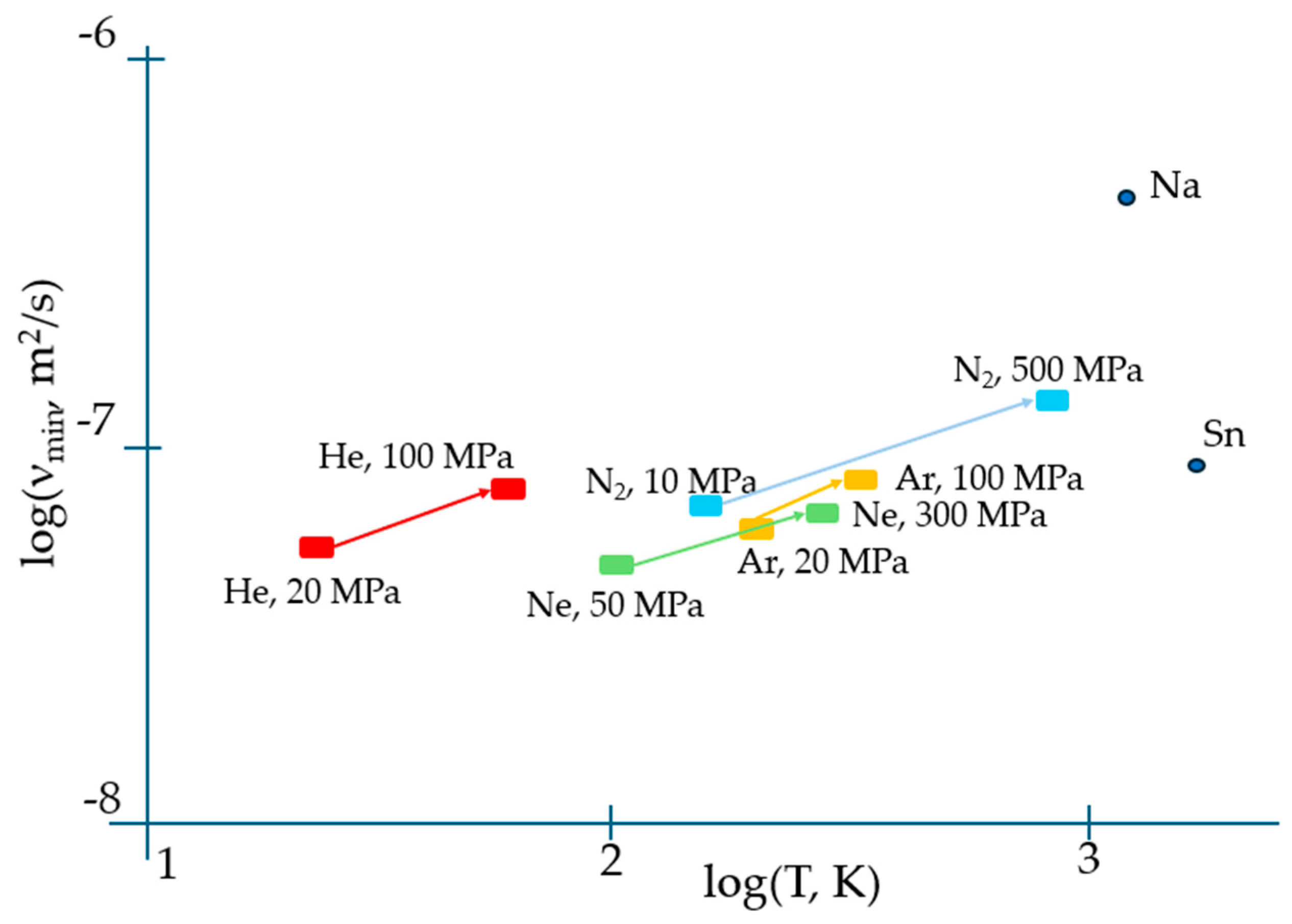
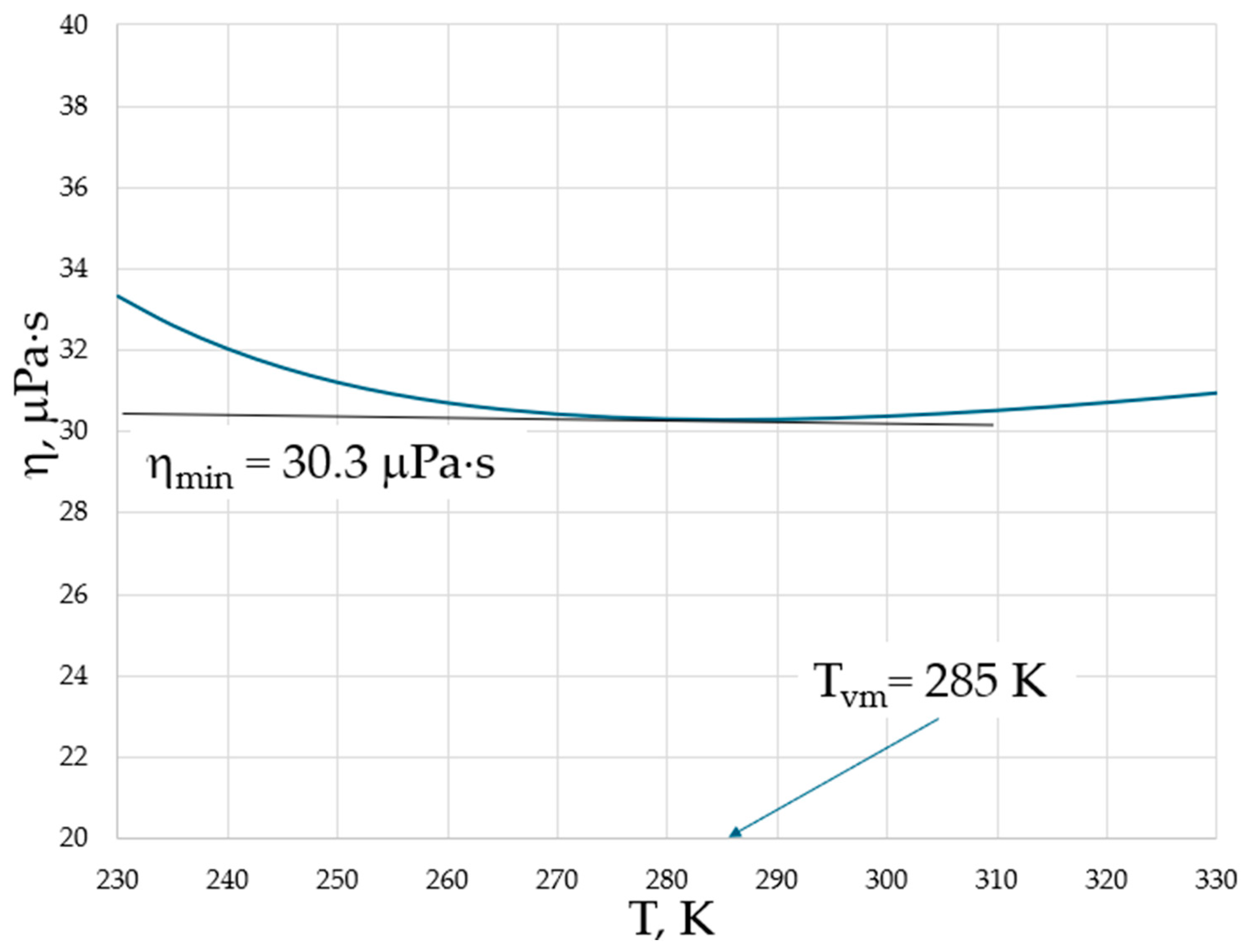
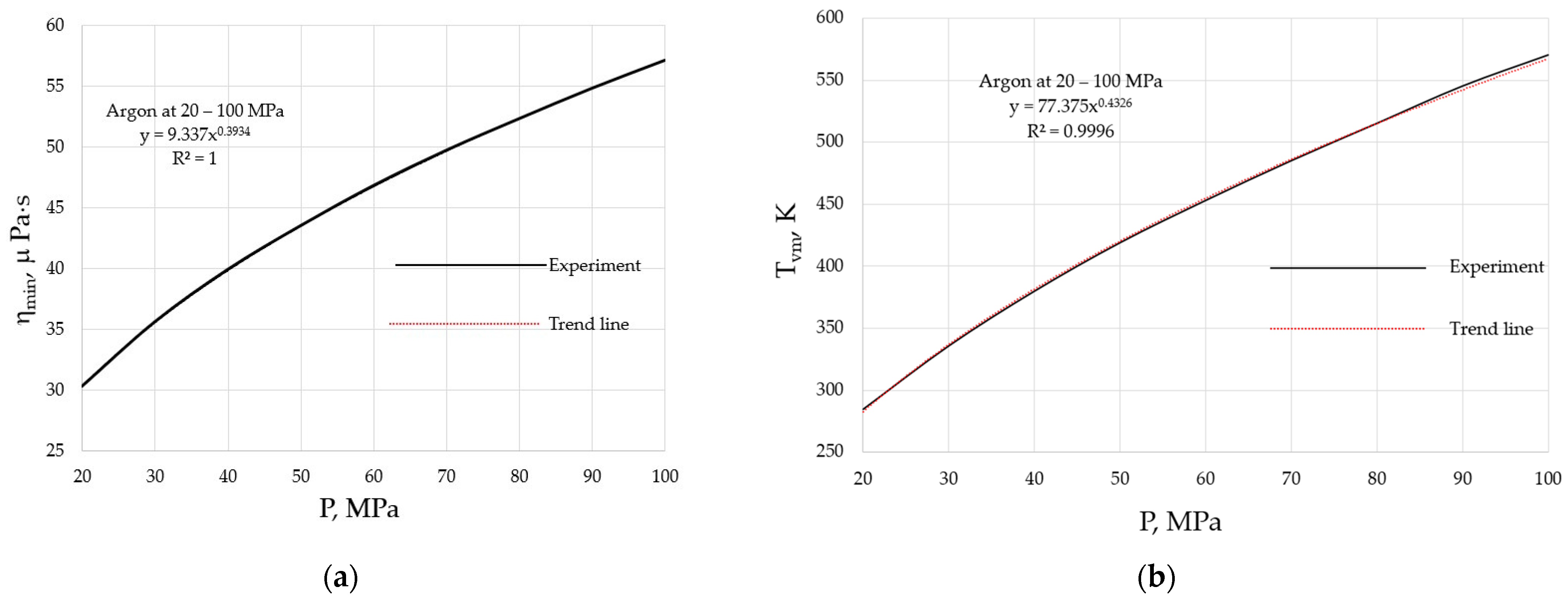
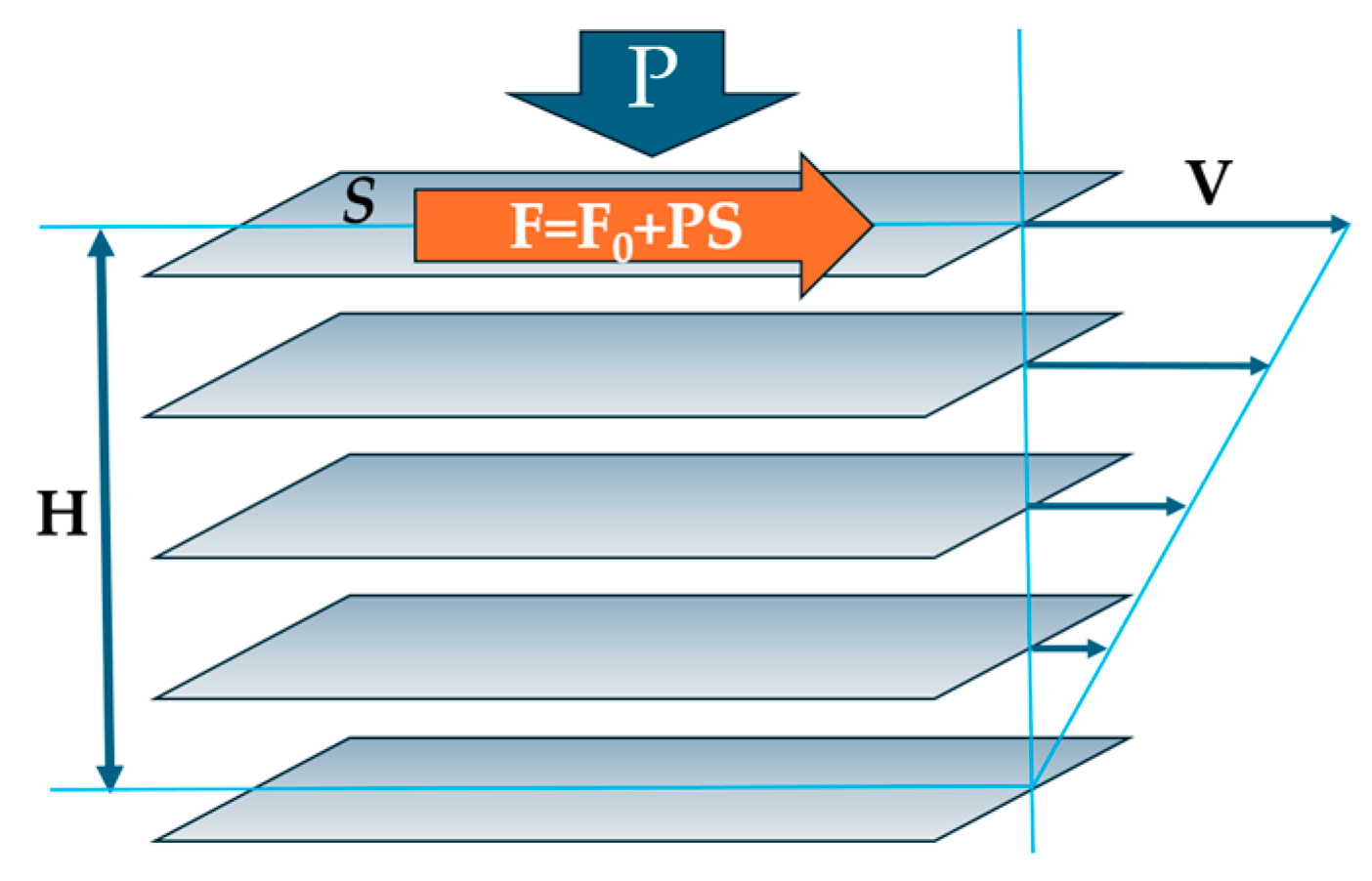
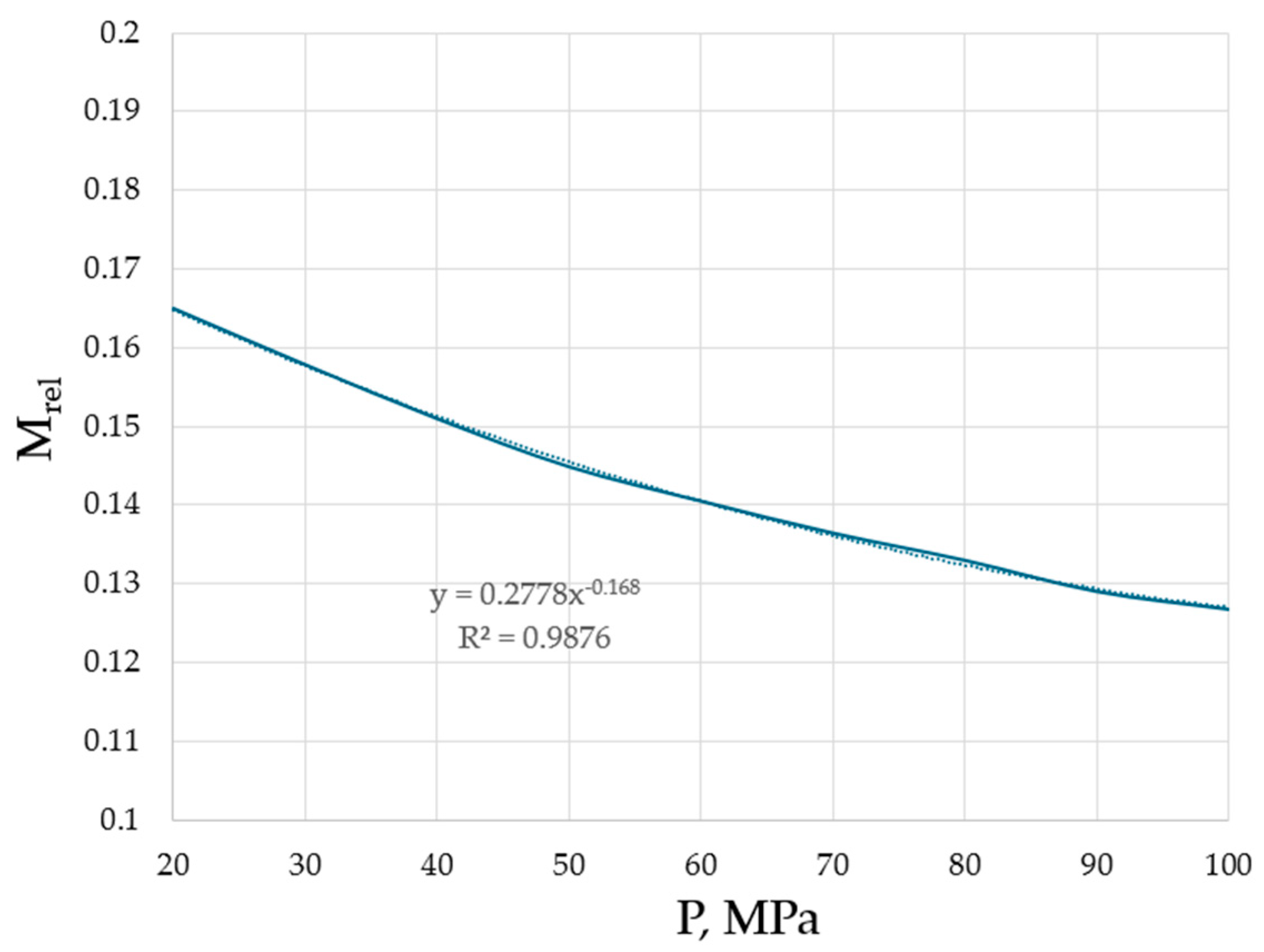
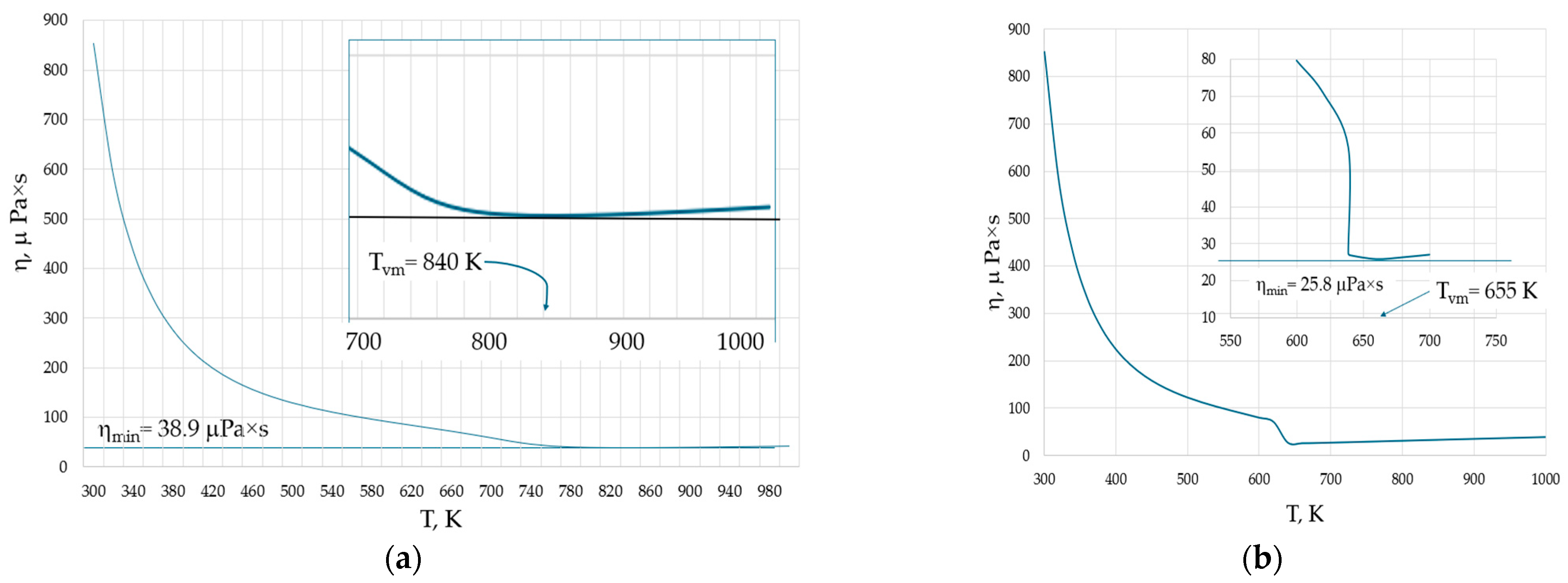
| Substance | Reference for ηmin,exper | Mrel |
|---|---|---|
| Neon (Ne) at 50 MPa | [7] 1 | 1.09 |
| Neon (Ne) at 300 MPa | [7] | 0.54 |
| Helium (He) at 20 MPa | [7] | 4.23 |
| Helium (He) at 100 MPa | [7] | 2.04 |
| Nitrogen (N2) at 10 MPa | [7] | 0.4 |
| Nitrogen (N2) at 500 MPa | [7] | 0.1 |
| Hydrogen (H2) at 50 MPa | [7] | 0.87 |
| Oxygen (O2) at 30 MPa | [7] | 0.26 |
| Water (H2O) at 100 MPa | [7] | 0.18 |
| Carbon dioxide (CO2) at 30 MPa | [7] | 0.16 |
| Methane (CH4) at 20 MPa | [7] | 0.24 |
| Carbon monoxide (CO) at 30 MPa | [7] | 0.28 |
| Tin (Sn) | [17] | 0.21 |
| Sodium (Na) | [18] | 0.07 |
Disclaimer/Publisher’s Note: The statements, opinions and data contained in all publications are solely those of the individual author(s) and contributor(s) and not of MDPI and/or the editor(s). MDPI and/or the editor(s) disclaim responsibility for any injury to people or property resulting from any ideas, methods, instructions or products referred to in the content. |
© 2024 by the authors. Licensee MDPI, Basel, Switzerland. This article is an open access article distributed under the terms and conditions of the Creative Commons Attribution (CC BY) license (https://creativecommons.org/licenses/by/4.0/).
Share and Cite
Ojovan, M.I.; Louzguine-Luzgin, D.V. The Minima of Viscosities. Materials 2024, 17, 1822. https://doi.org/10.3390/ma17081822
Ojovan MI, Louzguine-Luzgin DV. The Minima of Viscosities. Materials. 2024; 17(8):1822. https://doi.org/10.3390/ma17081822
Chicago/Turabian StyleOjovan, Michael I., and Dmitri V. Louzguine-Luzgin. 2024. "The Minima of Viscosities" Materials 17, no. 8: 1822. https://doi.org/10.3390/ma17081822
APA StyleOjovan, M. I., & Louzguine-Luzgin, D. V. (2024). The Minima of Viscosities. Materials, 17(8), 1822. https://doi.org/10.3390/ma17081822







